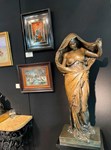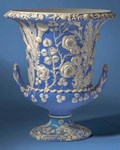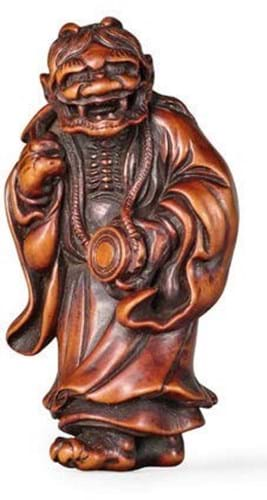
This 18th or 19th century Edo period wood netsuke by Sanko depicting an oni masquerading as a Buddhist monk and chanting the nenbutsu – an invocation to Amida Buddha – fetched a multi-estimate $76,000 (£63,000). The price for the 3in (8cm) high piece, last sold as part of the Cornelius Roosevelt collection in 1992, is among the highest for a netsuke of the demon folk figure. As ivory disappears from the market, fewer works by celebrated carvers such as Sanko are coming to market, increasing the competition for pieces like this and other rare wood netsuke such as the horned kirin that topped the Bonhams New York sale.
One of the most eagerly anticipated sales of netsuke to come to market in recent years did not disappoint with bullish prices and an auction record achieved at Bonhams New York (27.5/26/20/14.5% buyer’s premium).
The single-owner sale offered on December 16 came from the private collection of the Miami ophthalmologist Dr Joseph Kurstin (1933-2021), a major name in the world of netsuke collecting.

So-called ‘karakuri’ netsuke have moving parts. Fitted with a wind-up mechanism enabling it to move, this 2in (5.1cm) wide Meiji or Taisho period example of a seated toad surpassed modest expectations of $500-700 to sell for $13,000 (£11,000) at Bonhams New York.
Born in St Louis, Kurstin first encountered the small sculptural objects, which were once used by Japanese men to secure belongings to the sash of their kimonos, in 1958 while visiting an uncle.
The gift of a $9 ivory netsuke figure from his uncle that followed sparked a passion for Japanese carving that would last the rest of his life.
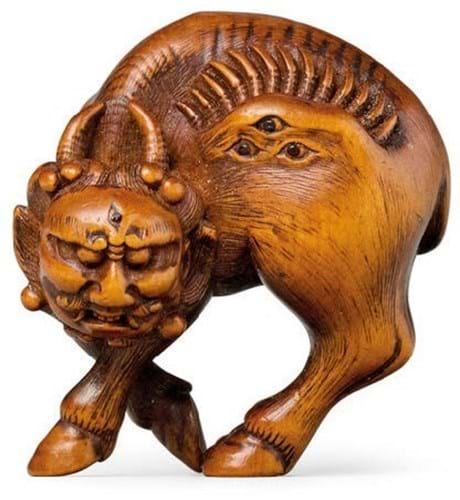
Rare legendary beasts such as this 18th century example of a hakutaku – a mythical cow-like beast with multiple eyes – are highly sought after by netsuke collectors. Shown mid-stride with an arched back, the 1¾in (4cm) high carving was taken to $64,000 (£53,000) at Bonhams New York, over nine times its top estimate.
“One of the nice things about this art is you can handle it. That’s how it gets its patina”, Kurstin told the Sarasota Herald-Tribune in 2011.
For over 40 years he travelled around the world looking for distinguished netsuke, amassing some 800 pieces, elements of which he loaned to major museums in North America and Japan.
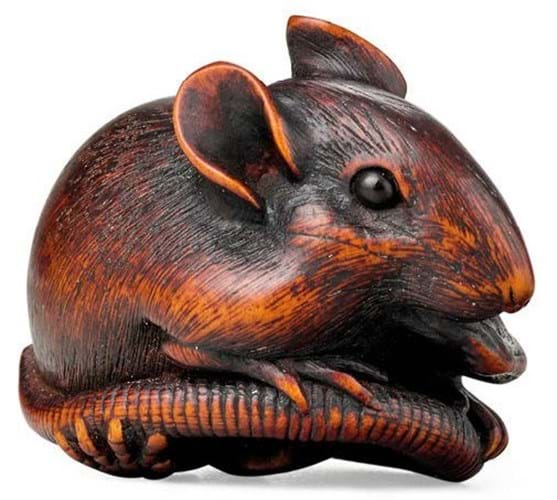
Arguably the most celebrated name associated with netsuke is Masanao of Kyoto, an 18th century maker who carved chiefly in ivory and is best known for his ability to realistically capture animals. The Bonhams New York sale featured no fewer than four wood netsuke by the Kyoto master – a boy with a rat, an octopus, a roosting chicken and this example of a rat nibbling on its hind paw – each one eagerly contested to the combined tune of around $220,000 (£182,000). The rat, which had made a premium-inclusive £25,000 on its previous auction outing as part of the Harriet Szechenyi collection in 2011, was knocked down for $75,000 (£62,000), three times its low estimate.
The jewel of his collection was the legendary Meinertzhagen kirin, a carving of a mythological animal, the whereabouts of which was unknown for decades until he eventually located it in London.
However, the select 61-lot sale of the Joseph and Elena Kurstin collection at Bonhams did not feature the Meinertzhagen kirin, nor any other piece made of ivory (as has become the practice for prominent dealers and major auction houses, such are the cultural sensibilities and regulations these days).
Instead, it focused on his 18th and 19th century Edo period wood netsuke.
Sought-after artists
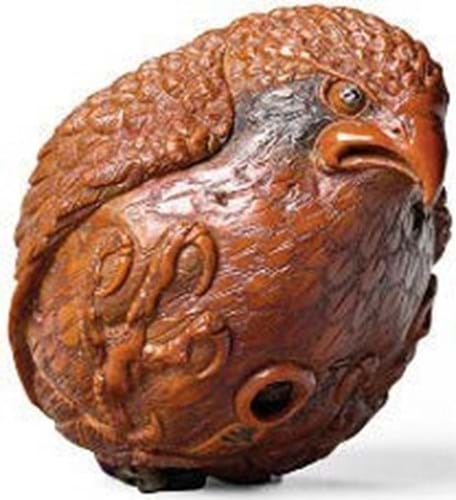
This quail netsuke, signed by Hidari Issan and dated 1797, is carved from walnut. A difficult and unforgiving material to work with, walnut netsuke are not widely collected on the secondary market. To prepare a walnut for carving the meat was removed by various means, including the insertion of a worm through a small hole to consume it. Estimated at $1000-1500, this superior example made $15,000 (£12,000) at Bonhams New York.
Among the major themes were mythical subjects and legends from Japanese folklore, animals, deities, and religious figures in addition to netsuke by sought-after artists such as Masanao of Kyoto – for which Kurstin’s group by the Kyoto master was renowned – Tametaka of Nagoya, Naito Toyomasa, and Seiyodo Tomiharu.
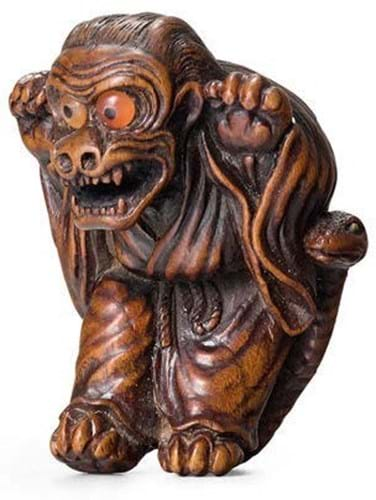
Along with the hakutaku and baku, the nue is one of the rarest mythological animals found in netsuke form. This 2in (5.5cm) high 18th century wood carving of the legendary beast with unusually large amber eyes is well known in collecting circles and sold for $65,000 (£54,000), well above its $35,000-40,000 guide at Bonhams New York. It was made by the Nagoya carver Tametaka, considered the founder of netsuke carving in Nagoya city in central Japan and admired for the intricate details and dynamism of his work.
The London based netsuke dealer Max Rutherston, who was present at the sale, described Kurstin as “one of the greatest netsuke collectors of his time, passionately engaged in the subject, with distinctive taste, and a man who always enjoyed sharing his collection with afficionados”. He added: “Bonhams was no doubt quietly confident that the sale would be successful, but one wonders if they knew to what extent?”
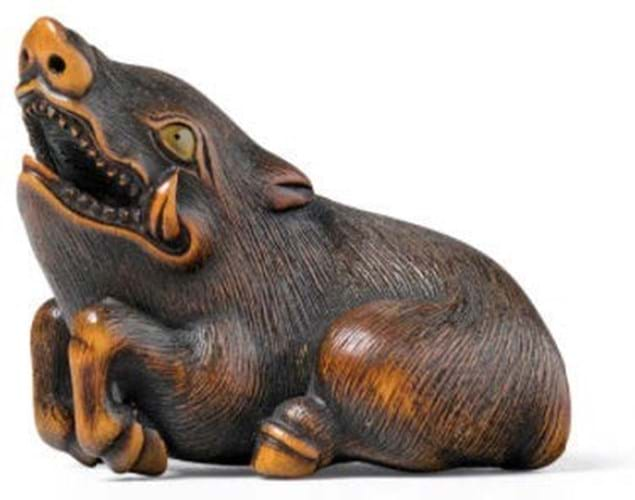
Indicative of the work of Tanba province animal carver Naitō Toyomasa (1773-1856), this signed c.1855 wood netsuke of this semi recumbent boar took $55,000 (£45,000) at Bonhams New York, nearly double its estimate. It was part of a group of four eagerly contested lots by Toyomasa, which combined made $130,000 (£107,000). “Clearly Toyomasa is riding a wave of popularity at the moment," said the London netsuke dealer Max Rutherston after the sale.
Boosted by the pedigree provenance and, with ivory disappearing, the increasingly competitive market for high-quality wood netsuke, many lots outstripped their estimates to rack up a $1.3m (£1.08m) total with a 93% sell-through rate and a sold by value rate of 100%.

Two views of the 18th century Edo period netsuke of a kirin on a cloud which sold for a record $350,000 (£287,000) at Bonhams New York as part of the Kurstin collection.
A record for any netsuke at auction was achieved for an 18th century Kyoto carving of the rare and legendary horned kirin surfing a wispy cloud (as reported in ATG No 2574). The 4in (10cm) high miniature masterwork had last sold as part of the Betty Jahss collection in 1991.
According to Rutherston, it had a few condition issues; one finger had been replaced, as well as the tip of another and the cloud formation had previously been separated from the figure in more than one place. Nonetheless, the netsuke had “a presence rarely found” and the consensus among specialists was that it was an unsigned work by the master carver Sanko.
With two bidders determined to have it, it soared over its conservative $15,000-20,000 guide to bring $350,000 (£287,000). The previous high for a netsuke was the £210,000 bid for an ivory shishi at Bonhams in London as part of the Harriet Szechenyi Collection in 2011.
£1 = $1.21


